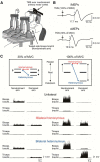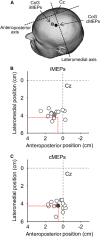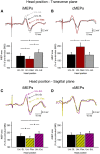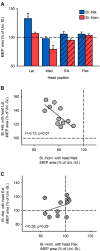Selective activation of ipsilateral motor pathways in intact humans
- PMID: 25319689
- PMCID: PMC4198538
- DOI: 10.1523/JNEUROSCI.1648-14.2014
Selective activation of ipsilateral motor pathways in intact humans
Abstract
It has been proposed that ipsilateral motor pathways play a role in the control of ipsilateral movements and recovery of function after injury. However, the extent to which ipsilateral motor pathways are engaged in voluntary activity in intact humans remains largely unknown. Using transcranial magnetic stimulation over the arm representation of the primary motor cortex, we examined ipsilateral motor-evoked potentials (iMEPs) in a proximal arm muscle during increasing levels of unilateral and bilateral isometric force in a sitting position. We demonstrate that iMEP area and amplitude decreased during bilateral contraction of homonymous (elbow flexor) muscles and increased during bilateral contraction of heteronymous (elbow flexor and extensor) muscles compared with a unilateral contraction, regardless of the level of force tested. To further understand the neuronal inputs involved in the bilateral effects, we examined the contribution from neck afferents projecting onto ipsilateral motor pathways. Medial (away from the muscle tested) and lateral (toward the muscle tested) rotation of the head enhanced bilateral iMEP effects from homonymous and heteronymous muscles, respectively. In contrast, head flexion and extension exerted nonspecific bilateral effects on iMEPs. Intracortical inhibition, in the motor cortex where iMEPs originated, showed modulation compatible with the changes in iMEPs. We conclude that ipsilateral projections to proximal arm muscles can be selectively modulated by voluntary contraction of contralateral arm muscles, likely involving circuits mediating asymmetric tonic neck reflexes acting, at least in part, at the cortical level. The pattern of bilateral actions may represent a strategy to engage ipsilateral motor pathways in a motor behavior.
Keywords: ipsilateral pathways; motor recovery; primary motor cortex; spinal cord injury; transcallosal pathways; voluntary movement.
Copyright © 2014 the authors 0270-6474/14/3313924-11$15.00/0.
Figures







Similar articles
-
Modulation of transcallosal inhibition by bilateral activation of agonist and antagonist proximal arm muscles.J Neurophysiol. 2014 Jan;111(2):405-14. doi: 10.1152/jn.00322.2013. Epub 2013 Oct 23. J Neurophysiol. 2014. PMID: 24155008 Free PMC article.
-
Organization of ipsilateral excitatory and inhibitory pathways in the human motor cortex.J Neurophysiol. 2003 Mar;89(3):1256-64. doi: 10.1152/jn.00950.2002. Epub 2002 Oct 30. J Neurophysiol. 2003. PMID: 12611955
-
Crossed corticospinal facilitation between arm and trunk muscles in humans.J Neurophysiol. 2018 Nov 1;120(5):2595-2602. doi: 10.1152/jn.00178.2018. Epub 2018 May 30. J Neurophysiol. 2018. PMID: 29847230 Free PMC article.
-
Further evidence for excitability changes in human primary motor cortex during ipsilateral voluntary contractions.Neurosci Lett. 2008 Mar 12;433(2):135-40. doi: 10.1016/j.neulet.2007.12.058. Epub 2008 Jan 10. Neurosci Lett. 2008. PMID: 18261851
-
Measurement of voluntary activation based on transcranial magnetic stimulation over the motor cortex.J Appl Physiol (1985). 2016 Sep 1;121(3):678-86. doi: 10.1152/japplphysiol.00293.2016. Epub 2016 Jul 14. J Appl Physiol (1985). 2016. PMID: 27418687 Review.
Cited by
-
Transcranial Magnetic Stimulation and Neocortical Neurons: The Micro-Macro Connection.Front Neurosci. 2022 Apr 12;16:866245. doi: 10.3389/fnins.2022.866245. eCollection 2022. Front Neurosci. 2022. PMID: 35495053 Free PMC article. Review.
-
Contralaterally Controlled Functional Electrical Stimulation Combined With Brain Stimulation for Severe Upper Limb Hemiplegia-Study Protocol for a Randomized Controlled Trial.Front Neurol. 2022 Apr 29;13:869733. doi: 10.3389/fneur.2022.869733. eCollection 2022. Front Neurol. 2022. PMID: 35599736 Free PMC article.
-
Bilateral Assessment of the Corticospinal Pathways of the Ankle Muscles Using Navigated Transcranial Magnetic Stimulation.J Vis Exp. 2019 Feb 19;(144):10.3791/58944. doi: 10.3791/58944. J Vis Exp. 2019. PMID: 30855569 Free PMC article.
-
Efficacy of contralaterally controlled functional electrical stimulation compared to cyclic neuromuscular electrical stimulation and task-oriented training for recovery of hand function after stroke: study protocol for a multi-site randomized controlled trial.Trials. 2022 May 12;23(1):397. doi: 10.1186/s13063-022-06303-y. Trials. 2022. PMID: 35549747 Free PMC article.
-
Determining the cortical, corticospinal, and reticulospinal responses to metronome-paced and self-paced strength training.Eur J Appl Physiol. 2025 Aug 31. doi: 10.1007/s00421-025-05939-3. Online ahead of print. Eur J Appl Physiol. 2025. PMID: 40886203
References
-
- Armand J, Kuypers HG. Cells of origin of crossed and uncrossed corticospinal fibers in the cat: a quantitative horseradish peroxidase study. Exp Brain Res. 1980;40:23–34. - PubMed
-
- Bawa P, Hamm JD, Dhillon P, Gross PA. Bilateral responses of upper limb muscles to transcranial magnetic stimulation in human subjects. Exp Brain Res. 2004;158:385–390. - PubMed
Publication types
MeSH terms
Grants and funding
LinkOut - more resources
Full Text Sources
Other Literature Sources
